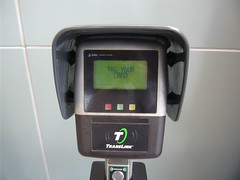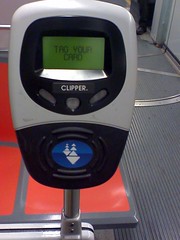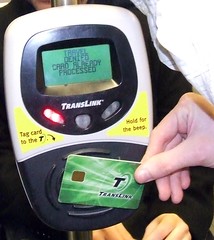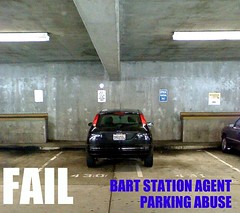
The conversion of paper Muni passes to only use an electronic farecard under TransLink & Clipper has been a very hot topic for the past couple of days with tons of comments (mostly from SF Gate, SFist and Muni Diaries) by citizens of our city and the Bay Area.
This blog entry is to give you the straight facts, answer your questions, and resolve the large amount of misinformation and rumor mill spreading around the comment boards.
I want you to give you the best information so you can be educated and make an informed choice to use the electronic farecard.
Why trust me and my blog?
A lot of people respect Akit's Complaint Department's coverage on TransLink & Clipper because I write about it the most often than any other news agency or local blog site in the Bay Area. I am your unofficial source of well detailed information, news, and opinion, even to the point where the agency refers people to my blog.
What are my credentials?
I have been a cardholder since 2002 when the program was on limited release to certain bus lines, train stations, and ferry lines (see proof). For the past eight years, I have paid for my transit rides using the card with e-cash only, a Muni pass, various valid electronic transfers, and through a commuter benefits company; I share my personal experiences to you readers so you understand how it works. I also conduct research by reading the agendas and meeting minutes of the TransLink management board, BART Board of Directors, and the SFMTA Board of Directors. My information, supported with documentation, has been used by other local prominent media such as SF Appeal.
How this lecture works:
In each topic, I will describe the basics, and if you are curious to learn more, you can read the additional details. To quickly read this article, just stick to the basics.
In some areas, there is just a bullet point list with no distinction between "basics" and "more details."
The TransLink & Clipper Program
Basics: The TL/Clipper program is a universal fare card system allowing passengers to easily transfer from one agency to another, without the need to pay in exact change, and carrying multiple passes and tickets.
More details: The public wanted a farecard that is universal with all Bay Area transit agencies. For those who commute to work in another city may depend on two or more transit agencies to get there, but it's such a hassle to carry lots of pocket change, or worry if the ticket purchased has no funds left on it. When first tested over 15 years ago, it was a magnetic stripe, but the agencies argued the machines installed on the buses was bulky and unreliable. It wasn't until the MTC decided to get the ball rolling and follow in the footsteps of the successful Hong Kong Octopus card that made boarding buses and trains quicker and faster. Today, TransLink is becoming Clipper on June 16th with more improvements on the way, and transit agencies are willing to end their paper passes in favor of electronic passes as a cost saving measure.
The [Physical] TransLink & Clipper Cards
Basics: It is a plastic, reusable fare card, and is similar to an ATM/Check card; but, it is not a magnetic stripe, it uses radio frequency technology to deduct fares from the "purse" or allow entry with a valid electronic pass.
More details: The card itself has an antenna surrounding the card. If you shine the TransLink card under a bright light with the white side facing towards you, you will see an antenna about one inch wide surrounding the entire card. The card itself contains a lot of data, from how much is left in the e-cash purse, what transfers are available, and what passes are still valid.
How to Obtain a Card
Basics: People can visit most Walgreens locations around the Bay Area, or visit their website to order one.
More details: Adults can obtain the card without the need to submit personal information.
But... if you are eligible for a discount transit fare or pass (youth, senior, or disabled), you must get a specially encoded card by registering for one. For youth and seniors, you must apply for the card at special sign-up tables or physically visit a transit agency's office. Documentation supporting a person's age is required in order to be issued a proper card.
The youth card is smart to know if the person's current age is eligible for a discount fare, such as if a 17 year old rides Muni, they pay the youth rate, but if they ride BART, they must be charged the adult rate because the youth ticket has a lower age limit. Once the passenger reaches the benchmark age (18), the card is automatically an adult card.
For seniors, they will get a card that clearly says "SENIOR" on it; this helps transit police and fare inspectors to make sure that a senior citizen is not passing on their eligible discounts to a non-eligible person.
For those with disabilities, one must register for a RTC discount card at their local transit agency office. The new RTC cards have the TransLink/Clipper technology loaded on it with all eligible public transit discounts available.
What Transit Agencies Participate in the Program?
Basics: Muni, BART, Golden Gate Transit, Golden Gate Ferry, AC Transit, and Caltrain.
More details: Samtrans and VTA are the next agencies to join the consortium. The goal is to get all the agencies to participate to create one seamless system.
UPDATE 12/9/10: Samtrans will join Clipper on December 15, 2010. VTA will join Clipper on February, 2011. -- End of Update --
How to Use the Card to Board Trains, Buses, Ferries, etc.
Basics: On vehicle card readers and stationary card readers (e.g. ferry terminal readers), walk to the reader, place the card over the black sensor zone, and hold the card steady on the zone until getting a green light and single confirmation tone. On train faregates, place the card over the sensor zone, hold the card steady, and wait for the gate to unlock or open. DO NOT quickly tap the card, swipe, or move it around the sensor zone as it will cause the reader to give no response or the error message (red light and three rapid beeps in high tone). You can also read the screen about the transaction that just happened.
For Golden Gate Transit, Caltrain, and BART passengers, you must "tag-off" in order to be charged the proper fare. Failure to do so may lock the card out, or be charged the maximum fare.
Watch this video about how to properly tag your card on BART and Caltrain:
A passenger's card can go into the negative balance. The maximum negative balance is $10, but once it goes negative, the card can't be used until replenished.
The card can read through your wallet or purse; secure the card closest to the wallet or purse's surface for successful tags every time. If the card is too far away, it won't read. Also, if in a RFID shield, or even tin foil, it won't work. Here's video footage when a card is wrapped in aluminum foil:
More details: A lot of people are giving misinformation about the card's programming...
- Let's say I am a Muni passenger, I have a valid Muni adult pass on my card and $20 of e-cash. When I board a Muni vehicle and tag my card, the TransLink/Clipper reader will recognize that I have a valid adult pass and will give me the green light to proceed; it will not deduct any e-cash balance. If the pass expired, and I don't have a valid pass for the new month, then the e-cash will be deducted.
- Let's say I just rode BART to Powell, exited with my electronic farecard, and boarded a Muni bus or entered the metro. Assuming that I do not have a valid Muni pass, the system will automatically recognize the existing transfer agreement between BART and Muni, where the passenger receives a 25 cent discount upon transferring to Muni. The transaction works like this: Instead of deducting $2.00 from the e-cash purse for Muni, it will deduct $1.75. The transfer agreement also allows me to return on Muni to BART by giving me a 25 cent discount on my next Muni transaction within a 24 hour period. (Exception: BART passengers who exits at Daly City gets a free ride on Muni away from the station and to the station on the appropriate bus lines: 28-19th Avenue, 28L-19th Avenue Limited, and 54 Felton with no deduction of e-cash, unless the rider does not return on Muni to BART within the 24 hour limit).
- Let's say I ride AC Transit, and I have $20 in e-cash and a Muni monthly pass covering that same month. When I tag my card on the AC Transit bus, the system will recognize that I have no valid AC Transit pass media and will deduct $2 from my e-cash purse. When I transfer to another AC Transit bus within the transfer time limit, the TransLink/Clipper card system will recognize the transfer first and only deduct 25 cents from the e-cash purse for the transfer fee.
What do the color lights and beeps mean? Here's a list:
- Green light and one beep: Valid fare paid, pass, or transfer for entry.
- Green light with yellow light and two beeps in different tones: Card has low e-cash value or just went into the negative.
- Red light and three high pitched beeps: Card blocked, card invalid, try card again, poor tagging of card, or a problem with the equipment.
- All three lights lit prior to tagging card: The reader is broken and won't respond.
How to Add Value to the Card
Basics: Visit a participating transit agency's ticketing office, use an automated add value machine, visit an official outlet/retail location such as a Walgreens, call the TransLink/Clipper customer service office, and use the TransLink/Clipper website. A cardholder can also request the autoload program; similar to FasTrak, when it reaches a low balance, your registered credit/debit card will be charged to replenish your e-cash, or if a pass expired, a new one can be automatically issued.
E-cash is the official universal electronic purse to deduct transit "cash fares" from all transit agencies. A customer can also purchase ride tickets and passes, regardless of what city or town it is purchased from (e.g. buying a Caltrain pass in Oakland).
More details: Here's a description of how each location works and what payments they accept.
- Transit agency ticketing offices accepts cash and commuter benefits vouchers. Adding funds and passes is instantly updated on the card for immediate use.
- Automated add value machines are located at major stations such as all Muni metro stations and all downtown SF BART stations. They accept cash, credit cards, debit cards, and commuter benefit debit cards. Adding funds and passes is instantly updated on the card for immediate use. BART ticketing machines will eventually be allowed to purchase TransLink/Clipper fare media.
- An official outlet or retail location is similar to a transit agency's ticketing office. They accept cash and commuter benefits vouchers. Although the location could accept credit cards, it WILL NOT accept commuter benefits debit cards. I highly recommend you do not attempt to use a commuter benefits debit card because it may get rejected or the benefits company will hound you for using it an unauthorized location. Adding funds and passes is instantly updated on the card for immediate use. UPDATE: Walgreens locations will accept commuter benefit paper vouchers. For other in-person vendors, call and check with them.
- Over the phone or TransLink website accepts credit cards, debit cards, and commuter benefits cards. Adding cash and passes has a waiting period of up to five days before the new value or pass will be available to use. Click here to read more about the five day policy. UPDATE: Link updated due to change in policy.
- Autoload registration must be done over the phone with TransLink/Clipper or by visiting their website. You must register the card under your name; anonymous cards (unregistered cards) cannot enroll in this program.
Basics: Never bend, break, or punch a hole in the card. It has a little leeway when bending, but treat the card like like it is a thin piece of glass and one drop or bend will shatter it. If you fear that you may render the card unusable, I suggest buying a protective sleeve that is rigid enough to resist bending and breaking.
More details: Bending, breaking, and punching a hole in the card will destroy the hidden antenna in the card and render it useless. Replacing the card with it's existing e-cash balance and/or passes is a serious pain.
Registering the Card or Not
Basics: Registering the card provides automatic protection in case you lose the card. When the card is lost, just call TransLink/Clipper and they will cancel the card, and issue you a new one by restoring your e-cash and/or passes. Not registering the card is the opposite, but gives people the advantage of anonymity.
More details: If you have that fear of being tracked everywhere you go, DO NOT register your card. Understand the risk that if you lose it or it gets stolen, that's the end. You will not have the right to a balance restoration, nor be eligible for the autoload program. To be completely anonymous, always add your e-cash and passes by paying in cash.
Unique Exceptions to the General Rules
- The TransLink card is still valid when the name changes to Clipper on June 16th. But the new Clipper card will be much more responsive than the old TransLink card.
- When riding a Cable Car, show the card to the conductor, and they will use their mobile card reader. Current Muni policy only allows monthly passholders to use this (e-cash not accepted).
- When riding Muni and a fare inspector has their card reader, present the card to the inspector to check for validity. It will not deduct your e-cash. The card reader can also show a history report of your most recent transactions and what type(s) of pass(es) you have on the card.
- Golden Gate Ferry and Transit customers with a TransLink/Clipper card pays the commuter discount rate, which is lower than the cash fare price. Only valid for adults, but all people eligible for discounts (disabled, senior, youth, etc.) pay the e-cash price which is lower than the commuter fare the adults pay with their card. For the ferry boats, this means a nearly 50% discount for adults.
- For those who use BART's high value tickets (e.g. $60 up front gets $64 in rides) a cardholder must register their card with TransLink/Clipper, enroll in autoload, and select automatic loading of the high value tickets. BART intends to change this policy in the future to allow non-autoload customers to have a separate BART e-cash purse.
- Caltrain has what I call a "suicide refund" or "delay policy." If you tagged-on at a station/platform reader and tag again at the same station's reader within 15 minutes, the card will be fully refunded. This is perfect if the train is delayed or service has been halted. My recommendation is to tag your card 15 minutes or less, prior to the arrival of the train.
- Caltrain passengers who have a pass can travel within the designated zones they paid for with no e-cash balance deduction. If I bought a monthly pass covering zones 1 to 3, I can ride within that area only. If going to zone 4, I must buy a one zone upgrade paper ticket. (This bullet point updated 11/1/10)
- Caltrain passengers with a monthly pass must tag their card to activate their pass on the first day of travel on the new month. Once activated, there is no need to tag the card, and the conductor/inspector will notice you have a valid pass covering the zones.
- Caltrain passengers must have at least $2.50 in e-cash fare, regardless if there is a pass or 8-ride ticket on the card. The unique tag-on and tag-off procedure automatically deducts the maximum fare of $11.25 when tagging-on, and will refund it upon tagging-off (being charged the proper fare for the ride). The $2.50 is necessary because the maximum negative balance is currently $10. (Update: This was corrected due to price hike on Caltrain)
Let's talk about problem resolution. Follow this sequence if you experience problems tagging your card to a reader:
- Is the card reader on? If not, tell the driver.
- If the screen is active prior to tagging my card, and did I see a red light, or all three color lights lit at once? If yes, it is not your fault; the reader is broken.
- If the reader is acting normally: If I got no response after tagging the card correctly, the card might be broken. But don't assume that yet, try another bus or train.
- If the reader is acting normally: If I got the red light, try tagging the card one more time, holding the card steady. Do not remove the card from the sensor until given the proper response.
- If the reader continues to give the red light, read the screen, and give TransLink/Clipper a call. If your credit card expired and you have autoload, your card gets locked-out until you update it. If you have no e-cash or it went negative, you need to replenish the card.
It's time to fight off the misinformation by others (humiliation!):
- There is no monthly service fee to have the card. If you don't get the card for free during the giveaway period, a one-time $5 fee is required; it's like a security deposit so people don't try to hoard on freebie cards.
- The same paper media you love to buy from transit agencies are available through TransLink/Clipper. It's just the transition away from paper to help save the earth from tickets and passes being thrown in the trash every month. Don't be like this commentator who made a dumb comment.
- It is impossible for a monthly pass holder for the agency they are allowed to ride to have their e-cash balance deducted when boarding the same agency's buses or trains. Hey dude, show me some proof, and maybe I'll believe you. When I had a Muni monthly pass and e-cash at the same time, boarding a Muni bus only recognized my pass and never touched my pool of e-cash.
- The paper adult Muni passes might go away in October. Interestingly, Muni Diaries first reported on it, but it's odd that Muni's website doesn't mention that (as of today).
- Someone said there is no 3-day grace period for the electronic Muni passes. I hate to ruin your party, there is a 3-day grace period for Muni passes on TransLink/Clipper. Kudos to the smart commentator.
- There is no fee to buy transit media for TransLink/Clipper online. But greedy ol' Muni will sure gouge you $2.50 if you buy the June paper pass on the SFMTA website.
- No, the fast pass won't be eliminated upon conversion to electronic ticketing only. If they did, passengers might break the door down at Muni Chief Nat Ford's office. Here's another idiot commenter, and another with a similar mention.
- There's a definite difference between FasTrak and Clipper. Duh!
Let's end it with a laugh:
Here's a fun slogan someone suggested on SFist about my idea to rename TransLink: "The Crab Card"
"[The Crab Card]: we've got crabs, and now you can too."
Thank you for reading! I hope this was helpful.
UPDATE: All links updated due to transition from TransLink to Clipper.
UPDATE: All links updated due to transition from TransLink to Clipper.






15 comments:
One more annoying drawback with BART and Tranklink/Clipper:
Direct Benefits allows small companies to get pre-tax transit directly from Translink. CommuterCheck, WageWorks, etc. cost companies a minimum of several hundred dollars a month, so since I am the only transit-riding person in my office, this is my only option. Problem is, you can't get BART High-Value tickets through Direct Benefits, only e-cash.
The HVD tickets offer a measly 6.7% discount, and pre-tax transit in my case saves about 16%. But stupidly, there is no way to get both of these discounts if you have a small employer.
My calls and emails to both Translink and BART have been ignored.
You are right, I totally forgot about the Direct Benefits program.
Thank you so much for taking the time to put this together. I and my non english speaking mom who is greatly confused about the whole process found it very informative.
I might have gone temporarily blind but I didn't see anything addressing this issue i just saw over at a comment on the Sfist:
"1) Fastpass does not reload until Muni grace period runs out on the 4th. Therefore need to use e-cash or a BART card to ride BART in the city from the 1st-3rd."
A comment or email to me would be loved, thank you again and sorry if i missed it in the post
Greetings Susan.
Here's the answer to your question to the best of my knowledge:
Let's assume this is June and you are using an "A" monthly Muni pass, and you have also pre-purchased your July "A" pass as well.
When it reaches July 1-3rd, when riding Muni, the card reader will still show your June pass expires on July 3rd, but that's how the system works. Once it hits July 4th, the reader will then say the expiration of your July pass is now August 3rd.
But, if you ride BART between the 1st and 3rd, the system will recognize that you have a monthly Muni pass covering the new month and will honor it as your local SF fare credit with no deduction to your e-cash balance.
Basically, the system exactly mimics the same rules used by paper media, such as the 90 minute rule on paper Muni transfers.
Ah, I understand now. Sorry for the late reply but thank you so much for answering.
Also thank you for continuing to update this blog with information :)
This is a great collection of information.
One little clarification to the Caltrain fare policy: the fare that it deducts depends on your starting zone. If you start in zone 1 or 6, it deducts a 6-zone one-way fare (currently $11.25). if you start in zone 2 or 5, it deducts a 5-zone one-way fare, and if you start in zone 3 or 4, it deducts a 4-zone one-way fare.
I was really confused the first time I used it and it deducted $11.25 in San Francisco but only $7.75 when boarding in Mountain View. But from Mountain View, the most I could travel is to Gilroy (4 zones).
I also really like the 15 minute refund period. When the trains are hosed, you can tag off and find another way to go.
Mike,
Thank you for the clarification and your compliments.
Thanks for the great summary! Regarding zone upgrades on Caltrain, my understanding is that Clipper does not currently support them.
The "Clipper on Caltrain" guide (http://www.clippercard.com/ClipperWeb/downloads/Clipper%20on%20Caltrain.pdf) instructs the user to purchase a paper zone upgrade.
The "Mr. Roadshow" column on 5/18/10 (http://www.mercurynews.com/mr-roadshow/ci_15112762) addresses this issue specifically, stating: "Riders who have monthly passes stored on Translink can use their Translink card to travel further than their monthly pass zone, but they will be charged the full fare. They will not get the discount they are entitled to as a monthly pass holder. If you want to get the discounted fare, you need to purchase a paper ticket at the Caltrain ticket vending machine. This will not be changing in the foreseeable future."
I got a letter from CalTrain saying that they want those of us getting monthly passes in the mail to transition to Clipper starting with October.
The problem is that a 2+ CalTrain monthly pass gives local fare credit on VTA. But while VTA busses all have Clipper terminals installed on them, they're all covered with black trash bags that say "out of order."
If VTA doesn't get their shit together by October, I an thousands of my fellow CalTrain monthly pass holders are going to be screwed.
Nick:
You'd better pray VTA will be ready in time. Also, Samtrans welcomes the 2+ zone Caltrain pass for local rides.
Thanks for this guide! Been using a fast pass since kindergarten and I'm so resistant to change. Just finally got my clipper card today. Hopefully I wont be one of those people holding up the line because my card won't tag.
I just found this guide, thanks! I have one problem; I have muni pass A, BART HVD and some e-cash just in case. But when I got from muni to bart, bart deducts from my e-cash and not the HVD. Is this normal?
That's not normal. Call Clipper for help.
Apologies if I missed this, buy if I have a Fast Pass on my clipper card, do I have to tag it when I board? If I don't and a fare inspector checks my card, will I get a fine? I'm assuming not because I have proof of payment (and we didn't have to show the paper pass) but would be interested in getting a definitive answer on this. If tagging isn't required I'll save myself and those behind me the time. Thanks.
Natalie: For Muni, yes, you should always tag your card every time you board. If the reader is busted, no, you don't have to tag, and the fare inspector can find out what fare media you have on your card.
The main reason why you should always tag your card is because it's the only way a bus driver can identify who has proper credentials (e-cash or pass) to enter as he/she can hear the single beep confirming allowable entry onto the bus. At the metro gates, you have to tag because it's the only way to get in.
As for boarding the metro at the surface, always tag so you don't get hassled during an inspection.
Post a Comment